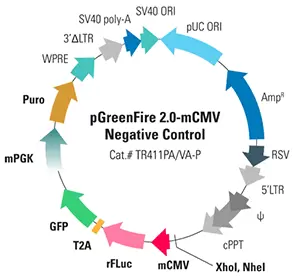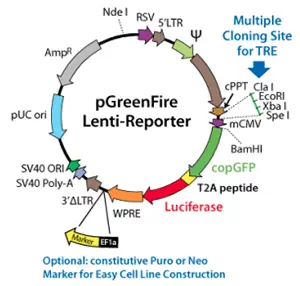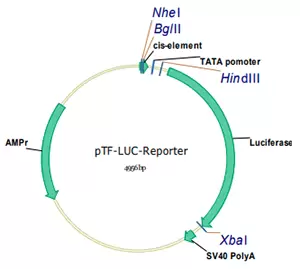
Transcription Factor Reporter Vectors
Monitor signal transduction and transcription factor activity in real time
Lentiviral pGreenFire 2.0 TF Dual Marker Reporter Vectors (rFLuc and GFP)
In the Lentiviral pGreenFire 2.0 TF Dual Marker Reporter Vectors, the core reporter functionality is similar to the original pGreenFire1 lentivector, see below. Transcriptional response elements (TREs) are placed upstream of a minimal CMV promoter (mCMV) which together drive co-expression of rFLuc (red firefly luciferase) and GFP in response to transcription factor activity. The result is the ability to quantitatively measure TF activity using both fluorescence and luciferase activity. What makes the next-gen pGreenFire 2.0 vectors even better than other TRE reporter vectors is the smart design, which adds in a constitutive selection cassette for stable cell line generation while minimizing interference with the upstream TRE. By using a weak/moderate mPGK promoter to drive the antibiotic selection marker (puromycin resistance) and carefully arranging the conditional reporter genes, the selection marker is reliably expressed without compromising conditional expression of rFLuc and GFP.
- Sort responsive cells with GFP
- Measure transcription factor activity with red firefly luciferase
- Create stable signaling pathway reporter cell lines using puromycin selection
- Introduce reporters into difficult-to-transfect cell types, including primary and non-dividing mammalian cell lines
- Available as plasmid DNA or as prepackaged pseudoviral particles

Map of pGreenFire 2.0 Cloning & Negative Control Vector.
*Please note that these vectors only function properly when transduced. Transfection keeps the constitutive RSV promoter intact, leading to nonspecific expression of the reporter genes.
Lentiviral pGreenFire1 TF Dual Marker Reporter Vectors (dcsGFP and Luciferase)
With the Lentiviral pGreenFire1 TF Dual Marker Reporter Vectors, you can monitor signal transduction in real time. These vectors co-express a destabilized copepod GFP (dscGFP; 2-hour half-life) and luciferase under control of transcriptional response elements (TREs) paired with a minimal CMV promoter (mCMV). The mCMV promoter alone delivers negligible expression, but when downstream of TF-responsive transcriptional elements, drives expression of dscGFP and luciferase in response to TF activity. The result is the ability to quantitatively measure TF activity by fluorescence and luciferase activity. Over 100 Lentiviral pGreenFire1 TF Dual Marker Reporter Vectors specific for different transcription factors are available.
- Sort responsive cells with dscGFP (destabilized copGFP)
- Measure transcription factor activity with luciferase
- Create stable signaling pathway reporter cell lines - vectors with puromycin or neomycin selection marker available
- Introduce reporters into difficult-to-transfect cell types, including primary and non-dividing mammalian cell lines
- Available as plasmid DNA or as prepackaged pseudoviral particles

Map of pGreenFire1 Vector.
*Please note that these vectors only function properly when transduced. Transfection keeps the constitutive RSV promoter intact, leading to nonspecific expression of the reporter genes.
TF Luciferase Reporter Vectors
TF luciferase reporter vectors are a series of firefly luciferase-based reporter constructs for the quantitative measurement of transcription factor activities in cells. Each vector contains a cis-element (DNA binding sequence), a minimal promoter, and firefly luciferase gene. When a TF is activated, it binds to the cis-element resulting in induction of luciferase gene expression. Therefore, luciferase activity represents the activity of the transcription factor.
- Functional assay - Monitor the transactivation of transcription factors in cells
- Quantitative analysis - Determine TF activation by quantitative measurement of luciferase activity
- Stable cell lines - The vectors can be used for establishing stable cells expressing the luciferase reporter
A large variety of luciferase reporter vectors specific for over 100 different transcription factors are provided with multiple reporter/selection marker options:
- TF Luciferase Reporter Vectors without selection marker
- HygroSelect TF Luciferase Reporter Vectors
- HygroSelect TF Luciferase Reporter Vectors with GFP
- NeoSelect TF Luciferase Reporter Vectors
- NeoSelect TF Luciferase Reporter Vectors with GFP

Map of pTF-Luc.